A Review on Rotary Generators of Hydrodynamic Cavitation for Wastewater Treatment and Enhancement of Anaerobic Digestion Process
Abstract
:1. Introduction
2. Anaerobic Digestion Process
2.1. Hydrolysis
2.2. Acidogenesis
2.3. Acetogenesis
2.4. Methanogenesis
2.5. Improving the Anaerobic Digestion Process
3. Advanced Oxidation Process
4. Cavitation
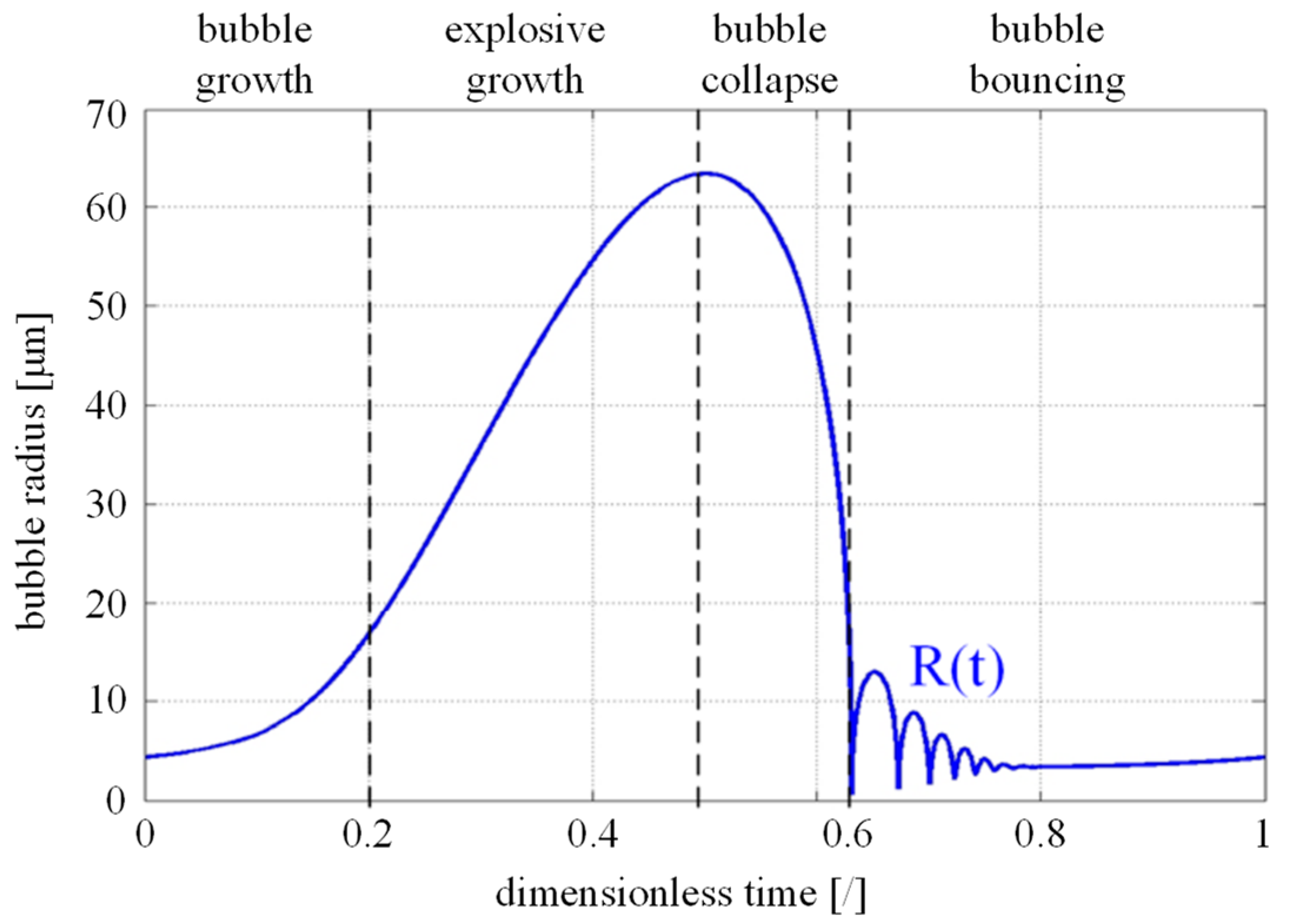
4.1. Types of Cavitation
4.2. Hydrodynamic Cavitation
4.3. Use of HC in Different Fields
4.4. Evaluation of Cavitation Conditions and Performance
5. Important RGHC Operating Parameters
5.1. Temperature
5.2. Inlet Pressure
5.3. pH
5.4. Residence Time
5.5. Rotational Speed
6. Rotational Hydrodynamic Cavitation Reactors
6.1. High-Speed Homogenizers and Cavitation Batch Reactors
6.2. Indentation Type RGHC
6.3. Radial Serrated Type RGHC
6.4. Axial Serrated RGHC
6.5. Pinned Disk RGHC
6.6. Hybrid Vaned Indentation RGHC
6.7. RGHC Comparison
7. Conclusions
Author Contributions
Funding
Data Availability Statement
Conflicts of Interest
References
- Albert, J.S.; Destouni, G.; Duke-Sylvester, S.M.; Magurran, A.E.; Oberdorff, T.; Reis, R.E.; Winemiller, K.O.; Ripple, W.J. Scientists’ Warning to Humanity on the Freshwater Biodiversity Crisis. AMBIO 2021, 50, 85–94. [Google Scholar] [CrossRef]
- Iyare, P.U.; Ouki, S.K.; Bond, T. Microplastics Removal in Wastewater Treatment Plants: A Critical Review. Environ. Sci. 2020, 6, 2664–2675. [Google Scholar] [CrossRef]
- Suárez, S.; Carballa, M.; Omil, F.; Lema, J.M. How Are Pharmaceutical and Personal Care Products (PPCPs) Removed from Urban Wastewaters? Rev. Environ. Sci. Biotechnol. 2008, 7, 125–138. [Google Scholar] [CrossRef]
- Schwarzenbach, R.P.; Gschwend, P.M.; Imboden, D.M. Environmental Organic Chemistry. In Environmental Organic Chemistry; John Wiley & Sons: New York, NY, USA, 2003; p. 1. [Google Scholar]
- Rout, P.R.; Zhang, T.C.; Bhunia, P.; Surampalli, R.Y. Treatment Technologies for Emerging Contaminants in Wastewater Treatment Plants: A Review. Sci. Total Environ. 2021, 753, 141990. [Google Scholar] [CrossRef] [PubMed]
- Gągol, M.; Przyjazny, A.; Boczkaj, G. Wastewater Treatment by Means of Advanced Oxidation Processes Based on Cavitation–A Review. Chem. Eng. J. 2018, 338, 599–627. [Google Scholar] [CrossRef]
- Gogate, P.R. Cavitation: An Auxiliary Technique in Wastewater Treatment Schemes. Adv. Environ. Res. 2002, 6, 335–358. [Google Scholar] [CrossRef]
- Thanekar, P.; Lakshmi, N.J.; Shah, M.; Gogate, P.R.; Znak, Z.; Sukhatskiy, Y.; Mnykh, R. Degradation of Dimethoate Using Combined Approaches Based on Hydrodynamic Cavitation and Advanced Oxidation Processes. Process Saf. Environ. Prot. 2020, 143, 222–230. [Google Scholar] [CrossRef]
- Montalvo Andia, J.P.; Ticona Cayte, A.E.; Illachura Rodriguez, J.M.; López Belón, L.; Cárdenas Málaga, M.A.; Teixeira, L.A.C. Combined Treatment Based on Synergism between Hydrodynamic Cavitation and H2O2 for Degradation of Cyanide in Effluents. Miner. Eng. 2021, 171, 107119. [Google Scholar] [CrossRef]
- Fedorov, K.; Sun, X.; Boczkaj, G. Combination of Hydrodynamic Cavitation and SR-AOPs for Simultaneous Degradation of BTEX in Water. Chem. Eng. J. 2021, 417, 128081. [Google Scholar] [CrossRef]
- Kadam, S.R.; Jadhav, N.L.; Pandit, A.B.; Pejaver, M.K. Degradation Kinetics and Mechanism of Hazardous Metribuzin Herbicide Using Advanced Oxidation Processes (HC &HC+ H2O2). Chem. Eng. Process.-Process Intensif. 2021, 166, 108486. [Google Scholar] [CrossRef]
- Tchobanoglous, G.; Stensel, H.D.; Tsuchihashi, R.; Burton, F.; Metcalf & Eddy, Inc. Wasteater Engineering: Treatment and Resource Recovery, 5th ed.; McGraw-Hill Education: New York, NY, USA, 2013; Volume 1. [Google Scholar]
- van Haandel, A.; van der Lubbe, J. Anaerobic Sewage Treatment: Optimization of Process and Physical Design of Anaerobic and Complementary Processes, 1st ed.; IWA Publishing: London, UK, 2019. [Google Scholar]
- Amoatey, P.; Bani, R. Wastewater Management. In Waste Water-Evaluation and Management; InTech: Hongkong, China, 2011. [Google Scholar]
- Hreiz, R.; Latifi, M.A.; Roche, N. Optimal Design and Operation of Activated Sludge Processes: State-of-the-Art. Chem. Eng. J. 2015, 281, 900–920. [Google Scholar] [CrossRef]
- Kolbl, S.; Forte-Tavčer, P.; Stres, B. Potential for Valorization of Dehydrated Paper Pulp Sludge for Biogas Production: Addition of Selected Hydrolytic Enzymes in Semi-Continuous Anaerobic Digestion Assays. Energy 2017, 126, 326–334. [Google Scholar] [CrossRef]
- Mata-Alvarez, J.; Dosta, J.; Romero-Güiza, M.S.; Fonoll, X.; Peces, M.; Astals, S. A Critical Review on Anaerobic Co-Digestion Achievements between 2010 and 2013. Renew. Sustain. Energy Rev. 2014, 36, 412–427. [Google Scholar] [CrossRef]
- Rivière, D.; Desvignes, V.; Pelletier, E.; Chaussonnerie, S.; Guermazi, S.; Weissenbach, J.; Li, T.; Camacho, P.; Sghir, A. Towards the Definition of a Core of Microorganisms Involved in Anaerobic Digestion of Sludge. ISME J. 2009, 3, 700–714. [Google Scholar] [CrossRef]
- Laiq Ur Rehman, M.; Iqbal, A.; Chang, C.C.; Li, W.; Ju, M. Anaerobic Digestion. Water Environ. Res. 2019, 91, 1253–1271. [Google Scholar] [CrossRef]
- Murovec, B.; Kolbl, S.; Stres, B. Methane Yield Database: Online Infrastructure and Bioresource for Methane Yield Data and Related Metadata. Bioresour. Technol. 2015, 189, 217–223. [Google Scholar] [CrossRef]
- Jiang, X.; Xie, Y.; Liu, M.; Bin, S.; Liu, Y.; Huan, C.; Ji, G.; Wang, X.; Yan, Z.; Lyu, Q. Study on Anaerobic Co-Digestion of Municipal Sewage Sludge and Fruit and Vegetable Wastes: Methane Production, Microbial Community and Three-Dimension Fluorescence Excitation-Emission Matrix Analysis. Bioresour. Technol. 2022, 347, 126748. [Google Scholar] [CrossRef]
- Chow, W.L.; Chong, S.; Lim, J.W.; Chan, Y.J.; Chong, M.F.; Tiong, T.J.; Chin, J.K.; Pan, G.T. Anaerobic Co-Digestion of Wastewater Sludge: A Review of Potential Co-Substrates and Operating Factors for Improved Methane Yield. Processes 2020, 8, 39. [Google Scholar] [CrossRef]
- Elalami, D.; Carrere, H.; Monlau, F.; Abdelouahdi, K.; Oukarroum, A.; Barakat, A. Pretreatment and Co-Digestion of Wastewater Sludge for Biogas Production: Recent Research Advances and Trends. Renew. Sustain. Energy Rev. 2019, 114, 109287. [Google Scholar] [CrossRef]
- Borowski, S. Co-Digestion of the Hydromechanically Separated Organic Fraction of Municipal Solid Waste with Sewage Sludge. J. Environ. Manag. 2015, 147, 87–94. [Google Scholar] [CrossRef]
- Gerardi, M.H. The Microbiology of Anaerobic Digesters; John Wiley & Sons, Inc.: Hoboken, NJ, USA, 2003; ISBN 0471206938. [Google Scholar]
- Deublein, D.; Steinhauser, A. Biogas from Waste and Renewable Resources; Wiley-VCH: Weinheim, Germany, 2011. [Google Scholar]
- Murphy, J.D. Thanasit Thamsiriroj Fundamental Science and Engineering of the Anaerobic Digestion Process for Biogas Production. In The Biogas Handbook; Elsevier: Amsterdam, The Netherlands, 2013; pp. 104–130. [Google Scholar]
- Liu, Y.; Whitman, W.B. Metabolic, Phylogenetic, and Ecological Diversity of the Methanogenic Archaea. Ann. N. Y. Acad. Sci. 2008, 1125, 171–189. [Google Scholar] [CrossRef] [PubMed]
- Sela-Adler, M.; Ronen, Z.; Herut, B.; Antler, G.; Vigderovich, H.; Eckert, W.; Sivan, O. Co-Existence of Methanogenesis and Sulfate Reduction with Common Substrates in Sulfate-Rich Estuarine Sediments. Front. Microbiol. 2017, 8, 766. [Google Scholar] [CrossRef] [PubMed]
- Zeikus, J.G.; Winfrey, M.R. Temperature Limitation of Methanogenesis in Aquatic Sediments. Appl. Environ. Microbiol. 1976, 31, 99–107. [Google Scholar] [CrossRef] [PubMed]
- Virpiranta, H.; Taskila, S.; Leiviskä, T.; Rämö, J.; Tanskanen, J. Development of a Process for Microbial Sulfate Reduction in Cold Mining Waters–Cold Acclimation of Bacterial Consortia from an Arctic Mining District. Environ. Pollut. 2019, 252, 281–288. [Google Scholar] [CrossRef]
- Kobayashi, T.; Li, Y.Y. Performance and Characterization of a Newly Developed Self-Agitated Anaerobic Reactor with Biological Desulfurization. Bioresour. Technol. 2011, 102, 5580–5588. [Google Scholar] [CrossRef]
- Kolbl, S.; Paloczi, A.; Panjan, J.; Stres, B. Addressing Case Specific Biogas Plant Tasks: Industry Oriented Methane Yields Derived from 5L Automatic Methane Potential Test Systems in Batch or Semi-Continuous Tests Using Realistic Inocula, Substrate Particle Sizes and Organic Loading. Bioresour. Technol. 2014, 153, 180–188. [Google Scholar] [CrossRef]
- Eastman, J.A.; Ferguson, J.F. Solubilization of Particulate Organic Carbon during the Acid Phase of Anaerobic Digestion. Water Pollut. Control Fed. 1981, 53, 352–366. [Google Scholar]
- Neis, U.; Nickel, K.; Tiehm, A. Enhancement of Anaerobic Sludge Digestion by Ultrasonic Disintegration. Water Sci. Technol. 2000, 42, 73–80. [Google Scholar] [CrossRef]
- Sawayama, S.; Inoue, S.; Minowa, T.; Tsukahara, K.; Ogi, T. Thermochemical Liquidization and Anaerobic Treatment of Kitchen Garbage. J. Ferment. Bioeng. 1997, 83, 451–455. [Google Scholar] [CrossRef]
- Benabdallah El-Hadj, T.; Dosta, J.; Márquez-Serrano, R.; Mata-Álvarez, J. Effect of Ultrasound Pretreatment in Mesophilic and Thermophilic Anaerobic Digestion with Emphasis on Naphthalene and Pyrene Removal. Water Res. 2007, 41, 87–94. [Google Scholar] [CrossRef]
- Petkovšek, M.; Mlakar, M.; Levstek, M.; Stražar, M.; Širok, B.; Dular, M. A Novel Rotation Generator of Hydrodynamic Cavitation for Waste-Activated Sludge Disintegration. Ultrason. Sonochem. 2015, 26, 408–414. [Google Scholar] [CrossRef]
- Carrère, H.; Dumas, C.; Battimelli, A.; Batstone, D.J.; Delgenès, J.P.; Steyer, J.P.; Ferrer, I. Pretreatment Methods to Improve Sludge Anaerobic Degradability: A Review. J. Hazard. Mater. 2010, 183, 1–15. [Google Scholar] [CrossRef]
- Zieliński, M.; Dębowski, M.; Kisielewska, M.; Nowicka, A.; Rokicka, M.; Szwarc, K. Comparison of Ultrasonic and Hydrothermal Cavitation Pretreatments of Cattle Manure Mixed with Straw Wheat on Fermentative Biogas Production. Waste Biomass Valorization 2019, 10, 747–754. [Google Scholar] [CrossRef]
- Vilarroig, J.; Martínez, R.; Zuriaga-Agustí, E.; Torró, S.; Galián, M.; Chiva, S. Design and Optimization of a Semi-industrial Cavitation Device for a Pretreatment of an Anaerobic Digestion Treatment of Excess Sludge and Pig Slurry. Water Environ. Res. 2020, 92, 2060–2071. [Google Scholar] [CrossRef]
- Bhat, A.P.; Gogate, P.R. Degradation of Nitrogen-Containing Hazardous Compounds Using Advanced Oxidation Processes: A Review on Aliphatic and Aromatic Amines, Dyes, and Pesticides. J. Hazard. Mater. 2021, 403, 123657. [Google Scholar] [CrossRef]
- de Lemos Chernicharo, C.A. Anaerobic Reactors; IWA Publishing: London, UK, 2007; Volume 6, ISBN 9781780402116. [Google Scholar] [CrossRef]
- Induchoodan, T.G.; Haq, I.; Kalamdhad, A.S. Factors Affecting Anaerobic Digestion for Biogas Production: A Review. Adv. Org. Waste Manag. Sustain. Pract. Approaches 2022, 223–233. [Google Scholar] [CrossRef]
- Gonzalez, J.M.; Stres, B. Trace Element Enzymes in Reactions Essential for Anaerobic Digestion. In Trace Elements in Anaerobic Biotechnologies; IWA Publishing: London, UK, 2019; pp. 51–72. [Google Scholar] [CrossRef]
- Bagal, M.V.; Gogate, P.R. Wastewater Treatment Using Hybrid Treatment Schemes Based on Cavitation and Fenton Chemistry: A Review. Ultrason. Sonochem. 2014, 21, 1–14. [Google Scholar] [CrossRef]
- Chen, Y.; Duan, X.; Zhou, X.; Wang, R.; Wang, S.; Ren, N.; Ho, S.-H. Advanced Oxidation Processes for Water Disinfection: Features, Mechanisms and Prospects. Chem. Eng. J. 2021, 409, 128207. [Google Scholar] [CrossRef]
- Deng, Y.; Zhao, R. Advanced Oxidation Processes (AOPs) in Wastewater Treatment. Curr. Pollut. Rep. 2015, 1, 167–176. [Google Scholar] [CrossRef] [Green Version]
- Asghar, A.; Abdul Raman, A.A.; Wan Daud, W.M.A. Advanced Oxidation Processes for In-Situ Production of Hydrogen Peroxide/Hydroxyl Radical for Textile Wastewater Treatment: A Review. J. Clean. Prod. 2015, 87, 826–838. [Google Scholar] [CrossRef]
- Aziz, H.A.; Mojiri, A. Wastewater Engineering: Advanced Wastewater Treatment Systems; IJSRPUB: Penang, Malaysia, 2014. [Google Scholar]
- Joshi, S.M.; Gogate, P.R. Intensification of Industrial Wastewater Treatment Using Hydrodynamic Cavitation Combined with Advanced Oxidation at Operating Capacity of 70 L. Ultrason. Sonochem. 2019, 52, 375–381. [Google Scholar] [CrossRef] [PubMed]
- Shah, Y.T.; Pandit, A.B.; Moholkar, V.S. Sources and Types of Cavitation. In Cavitation Reaction Engineering; Springer: Berlin/Heidelberg, Germany, 1999; pp. 1–14. [Google Scholar]
- Sipilä, T.P. Fundamentals of Cavitation. In Encyclopedia of Maritime and Offshore Engineering; John Wiley & Sons, Ltd.: Chichester, UK, 2017; pp. 1–11. [Google Scholar]
- Gogate, P.R.; Pandit, A.B. Hydrodynamic Cavitation Reactors: A State of the Art Review. Rev. Chem. Eng. 2001, 17, 1–85. [Google Scholar] [CrossRef]
- Brennen, C.E. Cavitation and Bubble Dynamics; Cambridge University Press: Cambridge, UK, 2013; ISBN 9781107338760. [Google Scholar]
- Harvey, E.N.; Barnes, D.K.; McElroy, W.D.; Whiteley, A.H.; Pease, D.C.; Cooper, K.W. Bubble Formation in Animals. I. Physical Factors. J. Cell. Comp. Physiol. 1944, 24, 1–22. [Google Scholar] [CrossRef]
- González-García, J.; Sáez, V.; Tudela, I.; Díez-Garcia, M.I.; Deseada Esclapez, M.; Louisnard, O. Sonochemical Treatment of Water Polluted by Chlorinated Organocompounds. A Review. Water 2010, 2, 28–74. [Google Scholar] [CrossRef]
- Lauterborn, W.; Vogel, A. Modern Optical Techniques in Fluid Mechanics. Annu. Rev. Fluid Mech. 1984, 16, 223–244. [Google Scholar] [CrossRef]
- Wang, Y.C.; Brennen, C.E. Shock Wave Development in the Collapse of a Cloud of Bubbles; American Society of Mechanical Engineers: New York, NY, USA, 1994. [Google Scholar]
- Franc, J.-P.; Michel, J.-M. Fundamentals of Cavitation; Kluwer Academic Publishers: Dordrecht, The Netherlands, 2005; Volume 76, ISBN 1-4020-2232-8. [Google Scholar]
- Dular, M.; Požar, T.; Zevnik, J.; Petkovšek, R. High Speed Observation of Damage Created by a Collapse of a Single Cavitation Bubble. Wear 2019, 418–419, 13–23. [Google Scholar] [CrossRef]
- Loraine, G.; Chahine, G.; Hsiao, C.-T.; Choi, J.-K.; Aley, P. Disinfection of Gram-Negative and Gram-Positive Bacteria Using DynaJets® Hydrodynamic Cavitating Jets. Ultrason. Sonochem. 2012, 19, 710–717. [Google Scholar] [CrossRef]
- Tong, R.P.; Schiffers, W.P.; Shaw, S.J.; Blake, J.R.; Emmony, D.C. The Role of ‘Splashing’ in the Collapse of a Laser-Generated Cavity near a Rigid Boundary. J. Fluid Mech. 1999, 380, 339–361. [Google Scholar] [CrossRef]
- Zevnik, J.; Dular, M. Cavitation Bubble Interaction with a Rigid Spherical Particle on a Microscale. Ultrason. Sonochem. 2020, 69, 105252. [Google Scholar] [CrossRef]
- Sun, X.; Liu, J.; Ji, L.; Wang, G.; Zhao, S.; Yoon, J.Y.; Chen, S. A Review on Hydrodynamic Cavitation Disinfection: The Current State of Knowledge. Sci. Total Environ. 2020, 737, 139606. [Google Scholar] [CrossRef]
- Gogate, P.R.; Patil, P.N. Combined Treatment Technology Based on Synergism between Hydrodynamic Cavitation and Advanced Oxidation Processes. Ultrason. Sonochem. 2015, 25, 60–69. [Google Scholar] [CrossRef]
- Save, S.S.; Pandit, A.B.; Joshi, J.B. Use of Hydrodynamic Cavitation for Large Scale Microbial Cell Disruption. Food Bioprod. Process. 1997, 75, 41–49. [Google Scholar] [CrossRef]
- Kim, H.; Sun, X.; Koo, B.; Yoon, J.Y. Experimental Investigation of Sludge Treatment Using a Rotor-Stator Type Hydrodynamic Cavitation Reactor and an Ultrasonic Bath. Processes 2019, 7, 790. [Google Scholar] [CrossRef]
- Ruiz-Hernando, M.; Martinez-Elorza, G.; Labanda, J.; Llorens, J. Dewaterability of Sewage Sludge by Ultrasonic, Thermal and Chemical Treatments. Chem. Eng. J. 2013, 230, 102–110. [Google Scholar] [CrossRef]
- Jyoti, K.K.; Pandit, A.B. Water Disinfection by Acoustic and Hydrodynamic Cavitation. Biochem. Eng. J. 2001, 7, 201–212. [Google Scholar] [CrossRef]
- Sivakumar, M.; Pandit, A.B. Wastewater Treatment: A Novel Energy Efficient Hydrodynamic Cavitational Technique. Ultrason. Sonochem. 2002, 9, 123–131. [Google Scholar] [CrossRef]
- Kolbl Repinc, S.; Bizjan, B.; Budhiraja, V.; Dular, M.; Gostiša, J.; Brajer Humar, B.; Kaurin, A.; Kržan, A.; Levstek, M.; Arteaga, J.F.M.; et al. Integral Analysis of Hydrodynamic Cavitation Effects on Waste Activated Sludge Characteristics, Potentially Toxic Metals, Microorganisms and Identification of Microplastics. Sci. Total Environ. 2022, 806, 151414. [Google Scholar] [CrossRef]
- Krishnan, J.S.; Dwivedi, P.; Moholkar, V.S. Numerical Investigation into the Chemistry Induced by Hydrodynamic Cavitation. Ind. Eng. Chem. Res. 2006, 45, 1493–1504. [Google Scholar] [CrossRef]
- Moholkar, V.S.; Pandit, A.B. Bubble Behavior in Hydrodynamic Cavitation: Effect of Turbulence. AIChE J. 1997, 43, 1641–1648. [Google Scholar] [CrossRef]
- Mevada, J.; Devi, S.; Pandit, A. Large Scale Microbial Cell Disruption Using Hydrodynamic Cavitation: Energy Saving Options. Biochem. Eng. J. 2019, 143, 151–160. [Google Scholar] [CrossRef]
- Lee, I.; Han, J.-I. The Effects of Waste-Activated Sludge Pretreatment Using Hydrodynamic Cavitation for Methane Production. Ultrason. Sonochem. 2013, 20, 1450–1455. [Google Scholar] [CrossRef] [PubMed]
- Cai, M.; Hu, J.; Lian, G.; Xiao, R.; Song, Z.; Jin, M.; Dong, C.; Wang, Q.; Luo, D.; Wei, Z. Synergetic Pretreatment of Waste Activated Sludge by Hydrodynamic Cavitation Combined with Fenton Reaction for Enhanced Dewatering. Ultrason. Sonochem. 2018, 42, 609–618. [Google Scholar] [CrossRef] [PubMed]
- Sun, X.; Jia, X.; Liu, J.; Wang, G.; Zhao, S.; Ji, L.; Yong Yoon, J.; Chen, S. Investigation on the Characteristics of an Advanced Rotational Hydrodynamic Cavitation Reactor for Water Treatment. Sep. Purif. Technol. 2020, 251, 117252. [Google Scholar] [CrossRef]
- Gostiša, J.; Širok, B.; Kolbl Repinc, S.; Levstek, M.; Stražar, M.; Bizjan, B.; Zupanc, M. Performance Evaluation of a Novel Pilot-Scale Pinned Disc Rotating Generator of Hydrodynamic Cavitation. Ultrason. Sonochem. 2021, 72, 105431. [Google Scholar] [CrossRef] [PubMed]
- Badve, M.; Gogate, P.; Pandit, A.; Csoka, L. Hydrodynamic Cavitation as a Novel Approach for Wastewater Treatment in Wood Finishing Industry. Sep. Purif. Technol. 2013, 106, 15–21. [Google Scholar] [CrossRef]
- Kalumuck, K.M.; Chahine, G.L. The Use of Cavitating Jets to Oxidize Organic Compounds in Water. J. Fluids Eng. 2000, 122, 465–470. [Google Scholar] [CrossRef]
- Stepišnik Perdih, T.; Širok, B.; Dular, M. Influence of Hydrodynamic Cavitation on Intensification of Laundry Aqueous Detergent Solution Preparation. Stroj. Vestn. J. Mech. Eng. 2017, 63, 83–91. [Google Scholar] [CrossRef]
- Gogate, P.R. Hydrodynamic Cavitation for Food and Water Processing. Food Bioprocess Technol. 2011, 4, 996–1011. [Google Scholar] [CrossRef]
- Min Oo, Y.; Prateepchaikul, G.; Somnuk, K. Continuous Acid-Catalyzed Esterification Using a 3D Printed Rotor–Stator Hydrodynamic Cavitation Reactor Reduces Free Fatty Acid Content in Mixed Crude Palm Oil. Ultrason. Sonochem. 2021, 72, 105419. [Google Scholar] [CrossRef]
- Cerecedo, L.M.; Dopazo, C.; Gomez-Lus, R. Water Disinfection by Hydrodynamic Cavitation in a Rotor-Stator Device. Ultrason. Sonochem. 2018, 48, 71–78. [Google Scholar] [CrossRef]
- Jyoti, K.K.; Pandit, A.B. Hybrid Cavitation Methods for Water Disinfection: Simultaneous Use of Chemicals with Cavitation. Ultrason. Sonochem. 2003, 10, 255–264. [Google Scholar] [CrossRef]
- Sawant, S.S.; Anil, A.C.; Krishnamurthy, V.; Gaonkar, C.; Kolwalkar, J.; Khandeparker, L.; Desai, D.; Mahulkar, A.V.; Ranade, V.V.; Pandit, A.B. Effect of Hydrodynamic Cavitation on Zooplankton: A Tool for Disinfection. Biochem. Eng. J. 2008, 42, 320–328. [Google Scholar] [CrossRef]
- Arrojo, S.; Benito, Y.; Martínez Tarifa, A. A Parametrical Study of Disinfection with Hydrodynamic Cavitation. Ultrason. Sonochem. 2008, 15, 903–908. [Google Scholar] [CrossRef]
- Kosel, J.; Gutiérrez-Aguirre, I.; Rački, N.; Dreo, T.; Ravnikar, M.; Dular, M. Efficient Inactivation of MS-2 Virus in Water by Hydrodynamic Cavitation. Water Res. 2017, 124, 465–471. [Google Scholar] [CrossRef]
- Sun, X.; Wang, Z.; Xuan, X.; Ji, L.; Li, X.; Tao, Y.; Boczkaj, G.; Zhao, S.; Yoon, J.Y.; Chen, S. Disinfection Characteristics of an Advanced Rotational Hydrodynamic Cavitation Reactor in Pilot Scale. Ultrason. Sonochem. 2021, 73, 105543. [Google Scholar] [CrossRef]
- Šarc, A.; Kosel, J.; Stopar, D.; Oder, M.; Dular, M. Removal of Bacteria Legionella Pneumophila, Escherichia Coli, and Bacillus Subtilis by (Super)Cavitation. Ultrason. Sonochem. 2018, 42, 228–236. [Google Scholar] [CrossRef]
- Jain, P.; Bhandari, V.M.; Balapure, K.; Jena, J.; Ranade, V.V.; Killedar, D.J. Hydrodynamic Cavitation Using Vortex Diode: An Efficient Approach for Elimination of Pathogenic Bacteria from Water. J. Environ. Manag. 2019, 242, 210–219. [Google Scholar] [CrossRef]
- Sun, X.; Xuan, X.; Ji, L.; Chen, S.; Liu, J.; Zhao, S.; Park, S.; Yoon, J.Y.; Om, A.S. A Novel Continuous Hydrodynamic Cavitation Technology for the Inactivation of Pathogens in Milk. Ultrason. Sonochem. 2021, 71, 105382. [Google Scholar] [CrossRef]
- Lee, A.K.; Lewis, D.M.; Ashman, P.J. Microalgal Cell Disruption by Hydrodynamic Cavitation for the Production of Biofuels. J. Appl. Phycol. 2015, 27, 1881–1889. [Google Scholar] [CrossRef]
- Patil, P.N.; Gogate, P.R.; Csoka, L.; Dregelyi-Kiss, A.; Horvath, M. Intensification of Biogas Production Using Pretreatment Based on Hydrodynamic Cavitation. Ultrason. Sonochem. 2016, 30, 79–86. [Google Scholar] [CrossRef]
- Mishra, K.P.; Gogate, P.R. Intensification of Degradation of Rhodamine B Using Hydrodynamic Cavitation in the Presence of Additives. Sep. Purif. Technol. 2010, 75, 385–391. [Google Scholar] [CrossRef]
- Rajoriya, S.; Bargole, S.; Saharan, V.K. Degradation of a Cationic Dye (Rhodamine 6G) Using Hydrodynamic Cavitation Coupled with Other Oxidative Agents: Reaction Mechanism and Pathway. Ultrason. Sonochem. 2017, 34, 183–194. [Google Scholar] [CrossRef] [PubMed]
- Baradaran, S.; Sadeghi, M.T. Coomassie Brilliant Blue (CBB) Degradation Using Hydrodynamic Cavitation, Hydrogen Peroxide and Activated Persulfate (HC-H2O2-KPS) Combined Process. Chem. Eng. Process. Process Intensif. 2019, 145, 107674. [Google Scholar] [CrossRef]
- Zupanc, M.; Kosjek, T.; Petkovšek, M.; Dular, M.; Kompare, B.; Širok, B.; Stražar, M.; Heath, E. Shear-Induced Hydrodynamic Cavitation as a Tool for Pharmaceutical Micropollutants Removal from Urban Wastewater. Ultrason. Sonochem. 2014, 21, 1213–1221. [Google Scholar] [CrossRef]
- LIN, H.; STOREY, B.D.; SZERI, A.J. Inertially Driven Inhomogeneities in Violently Collapsing Bubbles: The Validity of the Rayleigh–Plesset Equation. J. Fluid Mech. 2002, 452, 145–162. [Google Scholar] [CrossRef]
- Yan, Y.; Thorpe, R.B. Flow Regime Transitions Due to Cavitation in the Flow through an Orifice. Int. J. Multiph. Flow 1990, 16, 1023–1045. [Google Scholar] [CrossRef]
- Šarc, A.; Stepišnik-Perdih, T.; Petkovšek, M.; Dular, M. The Issue of Cavitation Number Value in Studies of Water Treatment by Hydrodynamic Cavitation. Ultrason. Sonochem. 2017, 34, 51–59. [Google Scholar] [CrossRef]
- Gogate, P.R.; Shirgaonkar, I.Z.; Sivakumar, M.; Senthilkumar, P.; Vichare, N.P.; Pandit, A.B. Cavitation Reactors: Efficiency Assessment Using a Model Reaction. AIChE J. 2001, 47, 2526–2538. [Google Scholar] [CrossRef]
- Ambulgekar, G.V.; Samant, S.D.; Pandit, A.B. Oxidation of Alkylarenes to the Corresponding Acids Using Aqueous Potassium Permanganate by Hydrodynamic Cavitation. Ultrason. Sonochem. 2004, 11, 191–196. [Google Scholar] [CrossRef]
- Patil, P.N.; Gogate, P.R. Degradation of Methyl Parathion Using Hydrodynamic Cavitation: Effect of Operating Parameters and Intensification Using Additives. Sep. Purif. Technol. 2012, 95, 172–179. [Google Scholar] [CrossRef]
- Wang, X.; Zhang, Y. Degradation of Alachlor in Aqueous Solution by Using Hydrodynamic Cavitation. J. Hazard. Mater. 2009, 161, 202–207. [Google Scholar] [CrossRef]
- Braeutigam, P.; Franke, M.; Schneider, R.J.; Lehmann, A.; Stolle, A.; Ondruschka, B. Degradation of Carbamazepine in Environmentally Relevant Concentrations in Water by Hydrodynamic-Acoustic-Cavitation (HAC). Water Res. 2012, 46, 2469–2477. [Google Scholar] [CrossRef]
- Petkovšek, M.; Zupanc, M.; Dular, M.; Kosjek, T.; Heath, E.; Kompare, B.; Širok, B. Rotation Generator of Hydrodynamic Cavitation for Water Treatment. Sep. Purif. Technol. 2013, 118, 415–423. [Google Scholar] [CrossRef]
- Dular, M.; Griessler-Bulc, T.; Gutierrez-Aguirre, I.; Heath, E.; Kosjek, T.; Krivograd Klemenčič, A.; Oder, M.; Petkovšek, M.; Rački, N.; Ravnikar, M.; et al. Use of Hydrodynamic Cavitation in (Waste)Water Treatment. Ultrason. Sonochem. 2016, 29, 577–588. [Google Scholar] [CrossRef]
- Gostiša, J.; Zupanc, M.; Dular, M.; Širok, B.; Levstek, M.; Bizjan, B. Investigation into Cavitational Intensity and COD Reduction Performance of the Pinned Disc Reactor with Various Rotor-Stator Arrangements. Ultrason. Sonochem. 2021, 77, 105669. [Google Scholar] [CrossRef]
- Sun, X.; Yang, Z.; Wei, X.; Tao, Y.; Boczkaj, G.; Yoon, J.Y.; Xuan, X.; Chen, S. Multi-Objective Optimization of the Cavitation Generation Unit Structure of an Advanced Rotational Hydrodynamic Cavitation Reactor. Ultrason. Sonochem. 2021, 80, 105771. [Google Scholar] [CrossRef]
- Sun, X.; Kang, C.H.; Park, J.J.; Kim, H.S.; Om, A.S.; Yoon, J.Y. An Experimental Study on the Thermal Performance of a Novel Hydrodynamic Cavitation Reactor. Exp. Therm. Fluid Sci. 2018, 99, 200–210. [Google Scholar] [CrossRef]
- Sun, X.; Park, J.J.; Kim, H.S.; Lee, S.H.; Seong, S.J.; Om, A.S.; Yoon, J.Y. Experimental Investigation of the Thermal and Disinfection Performances of a Novel Hydrodynamic Cavitation Reactor. Ultrason. Sonochem. 2018, 49, 13–23. [Google Scholar] [CrossRef]
- Sun, X.; Xuan, X.; Song, Y.; Jia, X.; Ji, L.; Zhao, S.; Yong Yoon, J.; Chen, S.; Liu, J.; Wang, G. Experimental and Numerical Studies on the Cavitation in an Advanced Rotational Hydrodynamic Cavitation Reactor for Water Treatment. Ultrason. Sonochem. 2021, 70, 105311. [Google Scholar] [CrossRef]
- Sun, X.; You, W.; Xuan, X.; Ji, L.; Xu, X.; Wang, G.; Zhao, S.; Boczkaj, G.; Yoon, J.Y.; Chen, S. Effect of the Cavitation Generation Unit Structure on the Performance of an Advanced Hydrodynamic Cavitation Reactor for Process Intensifications. Chem. Eng. J. 2021, 412, 128600. [Google Scholar] [CrossRef]
- Kim, H.; Koo, B.; Sun, X.; Yoon, J.Y. Investigation of Sludge Disintegration Using Rotor-Stator Type Hydrodynamic Cavitation Reactor. Sep. Purif. Technol. 2020, 240, 116636. [Google Scholar] [CrossRef]
- Maršálek, B.; Zezulka, Š.; Maršálková, E.; Pochylý, F.; Rudolf, P. Synergistic Effects of Trace Concentrations of Hydrogen Peroxide Used in a Novel Hydrodynamic Cavitation Device Allows for Selective Removal of Cyanobacteria. Chem. Eng. J. 2020, 382, 122383. [Google Scholar] [CrossRef]
- Zupanc, M.; Kosjek, T.; Petkovšek, M.; Dular, M.; Kompare, B.; Širok, B.; Blažeka, Ž.; Heath, E. Removal of Pharmaceuticals from Wastewater by Biological Processes, Hydrodynamic Cavitation and UV Treatment. Ultrason. Sonochem. 2013, 20, 1104–1112. [Google Scholar] [CrossRef] [PubMed]
- Šarc, A.; Oder, M.; Dular, M. Can Rapid Pressure Decrease Induced by Supercavitation Efficiently Eradicate Legionella Pneumophila Bacteria? Desalination Water Treat. 2016, 57, 2184–2194. [Google Scholar] [CrossRef]
- Kosel, J.; Šinkovec, A.; Dular, M. A Novel Rotation Generator of Hydrodynamic Cavitation for the Fibrillation of Long Conifer Fibers in Paper Production. Ultrason. Sonochem. 2019, 59, 104721. [Google Scholar] [CrossRef]
- Sežun, M.; Kosel, J.; Zupanc, M.; Hočevar, M.; Vrtovšek, J.; Petkovšek, M.; Dular, M. Cavitation as a Potential Technology for Wastewater Management–An Example of Enhanced Nutrient Release from Secondary Pulp and Paper Mill Sludge. Stroj. Vestn. J. Mech. Eng. 2019, 65, 641–649. [Google Scholar] [CrossRef]
- Fu, S.; Lu, J.; Zhou, F.; Yuan, H.; Wang, Y.; Dai, C. Study on the Performance of a Novel Hydrodynamic Cavitation Device for Treatment of Wastewater. Asia-Pac. J. Chem. Eng. 2022, 17, e2752. [Google Scholar] [CrossRef]
- Song, Y.; Hou, R.; Liu, Z.; Liu, J.; Zhang, W.; Zhang, L. Cavitation Characteristics Analysis of a Novel Rotor-Radial Groove Hydrodynamic Cavitation Reactor. Ultrason. Sonochem. 2022, 86, 106028. [Google Scholar] [CrossRef]
- Hou, R.; Song, Y.; Liu, J.; Zhang, L.; Zhang, M.; Sun, X. Experimental and Numerical Investigation on the Disinfection Characteristics of a Novel Rotor-Radial Groove Hydrodynamic Cavitation Reactor. Process Saf. Environ. Prot. 2023, 169, 260–269. [Google Scholar] [CrossRef]

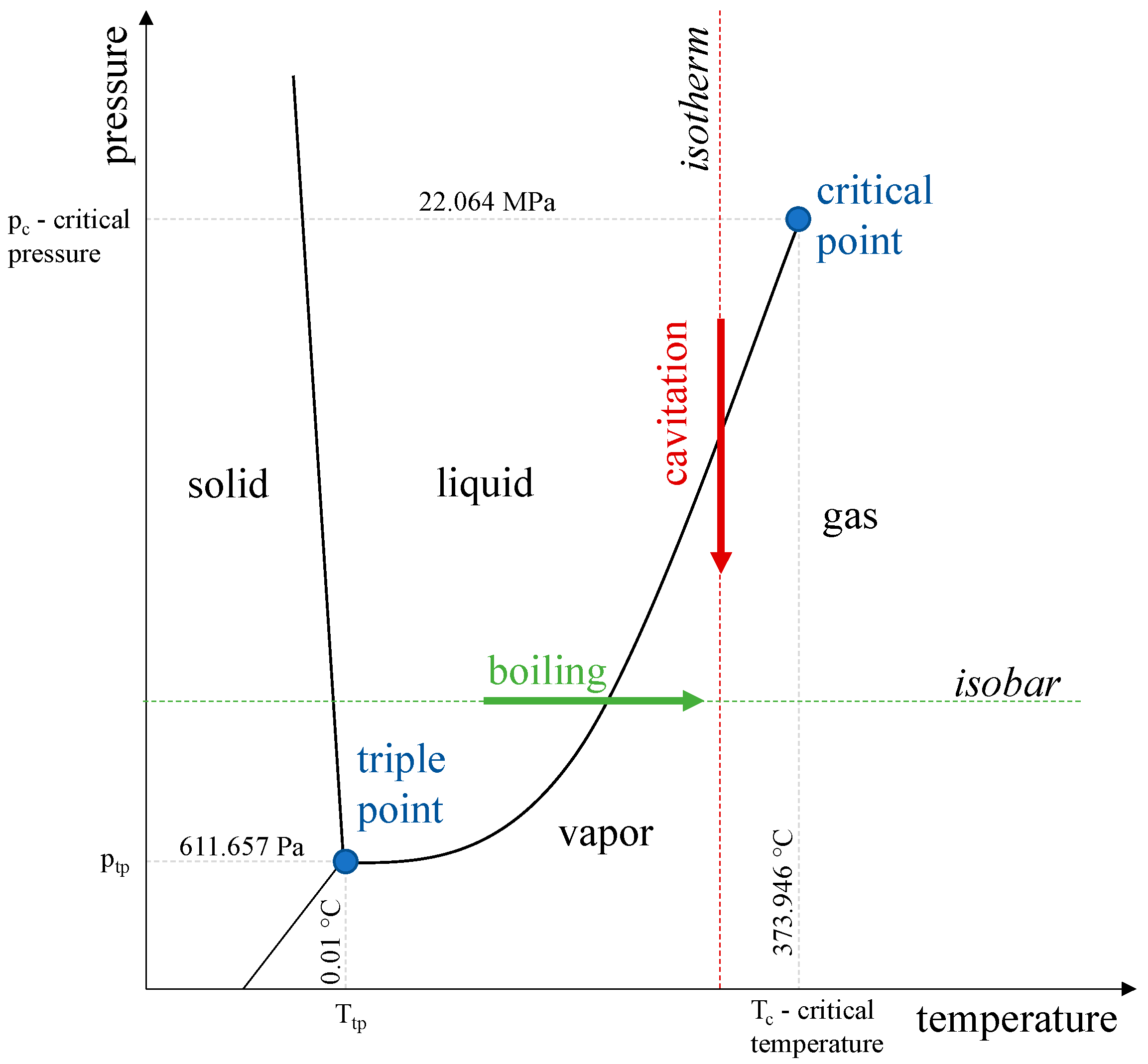

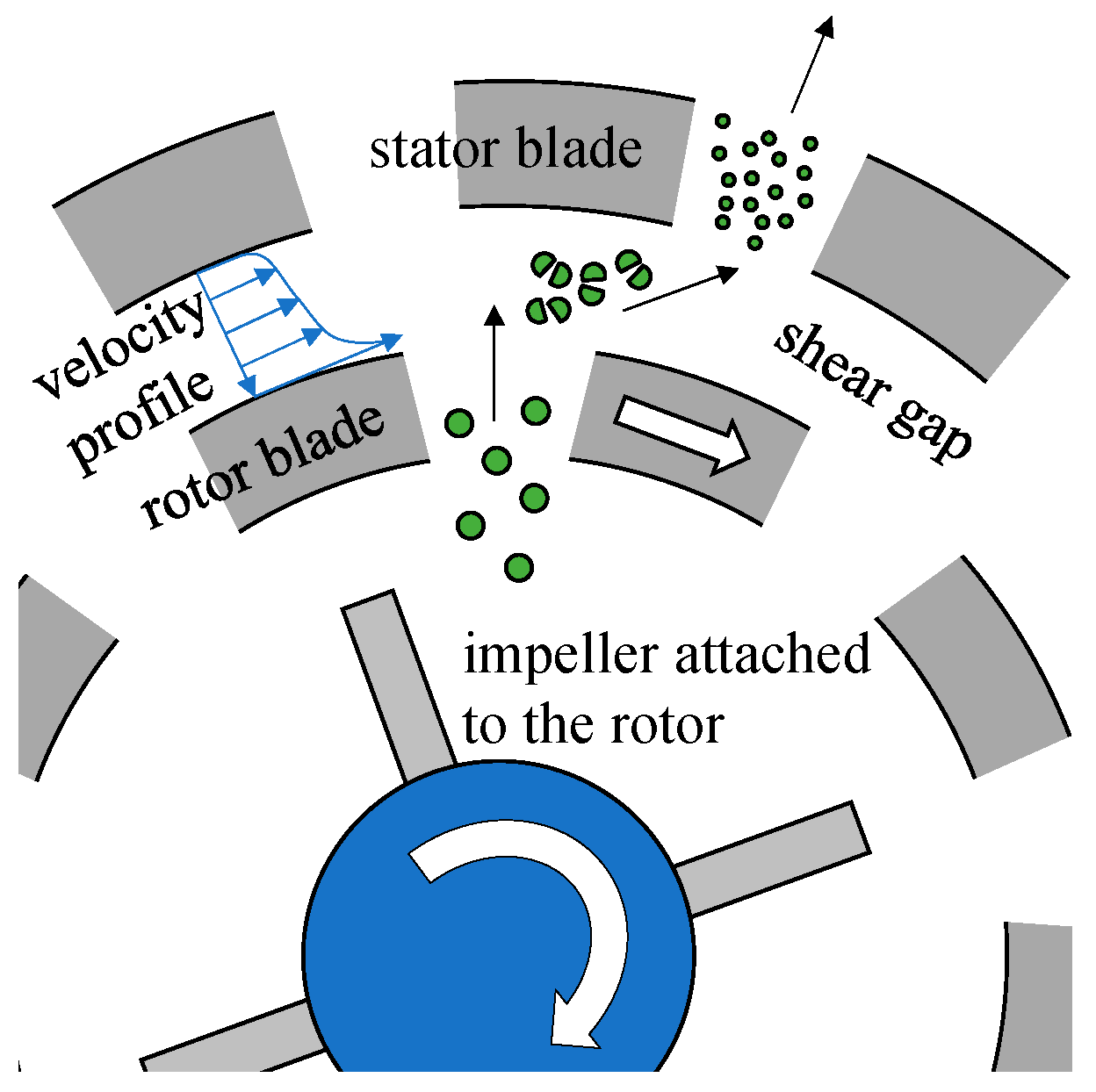
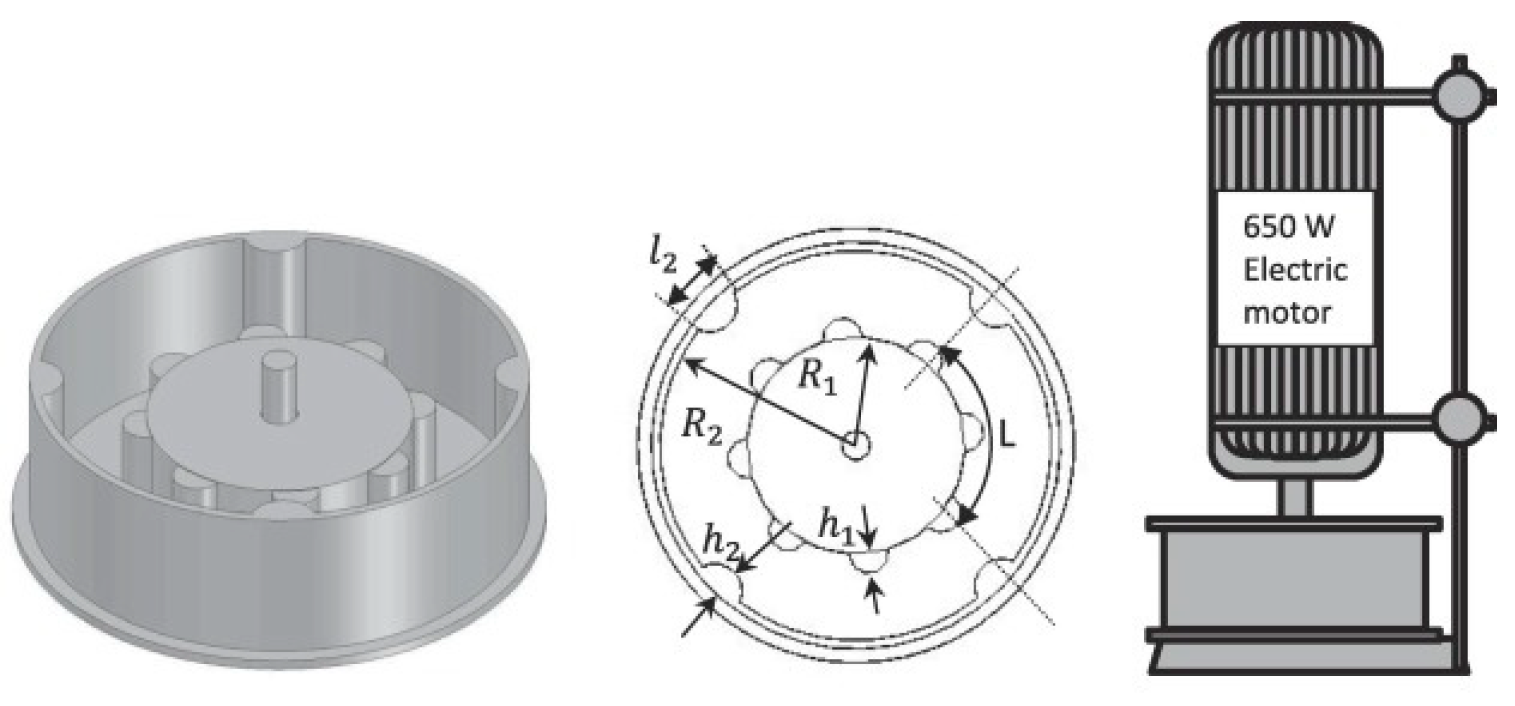
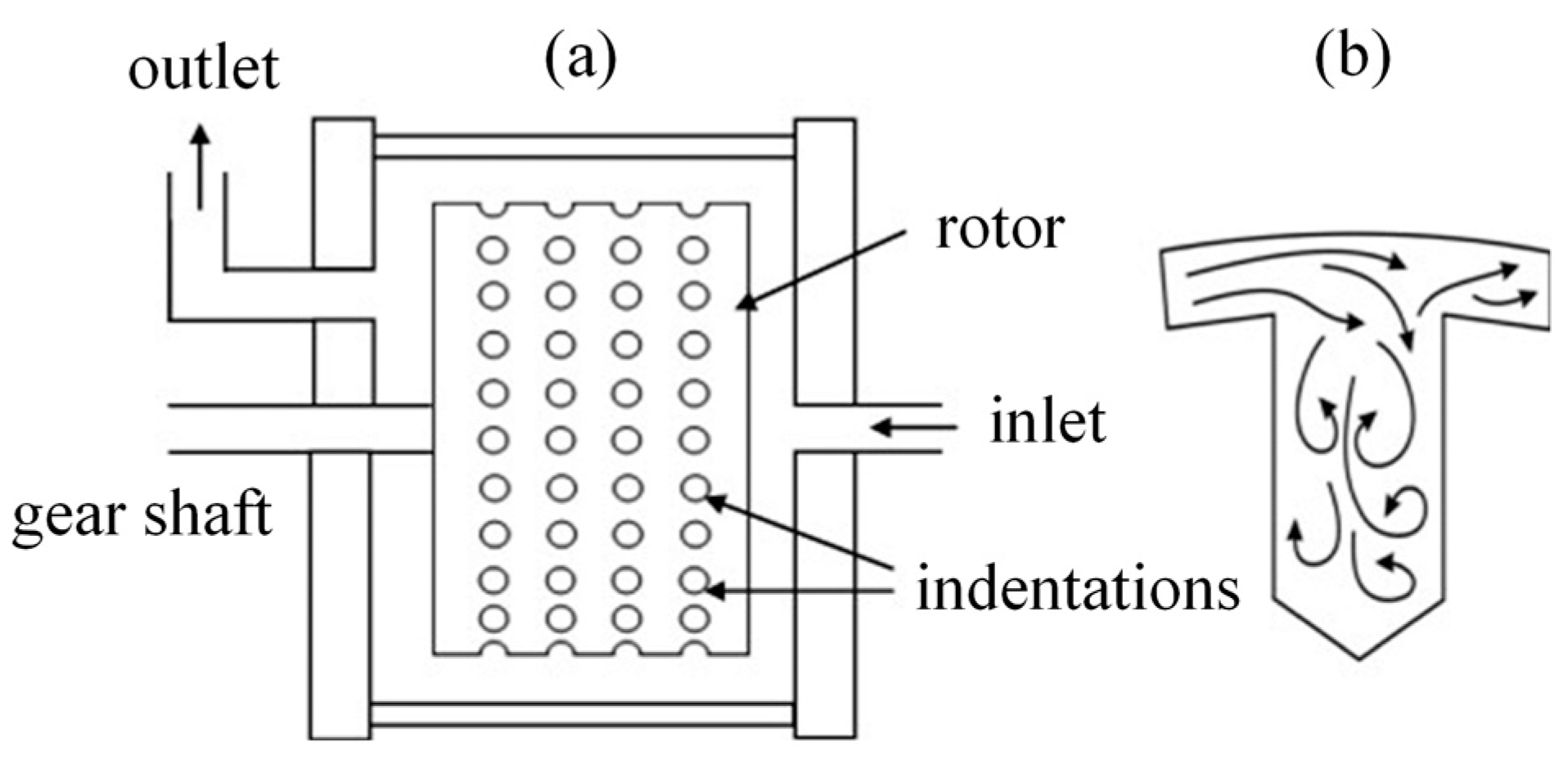
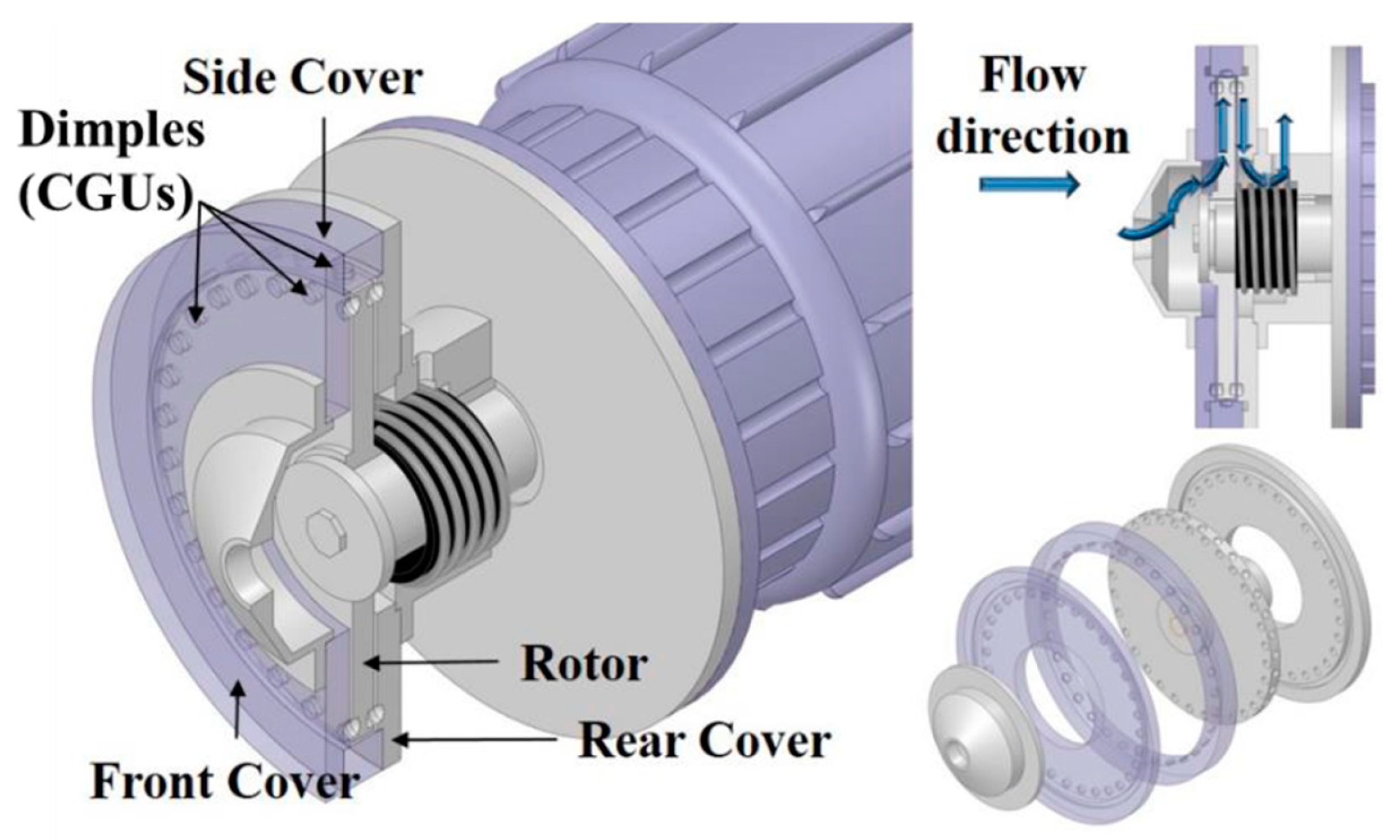

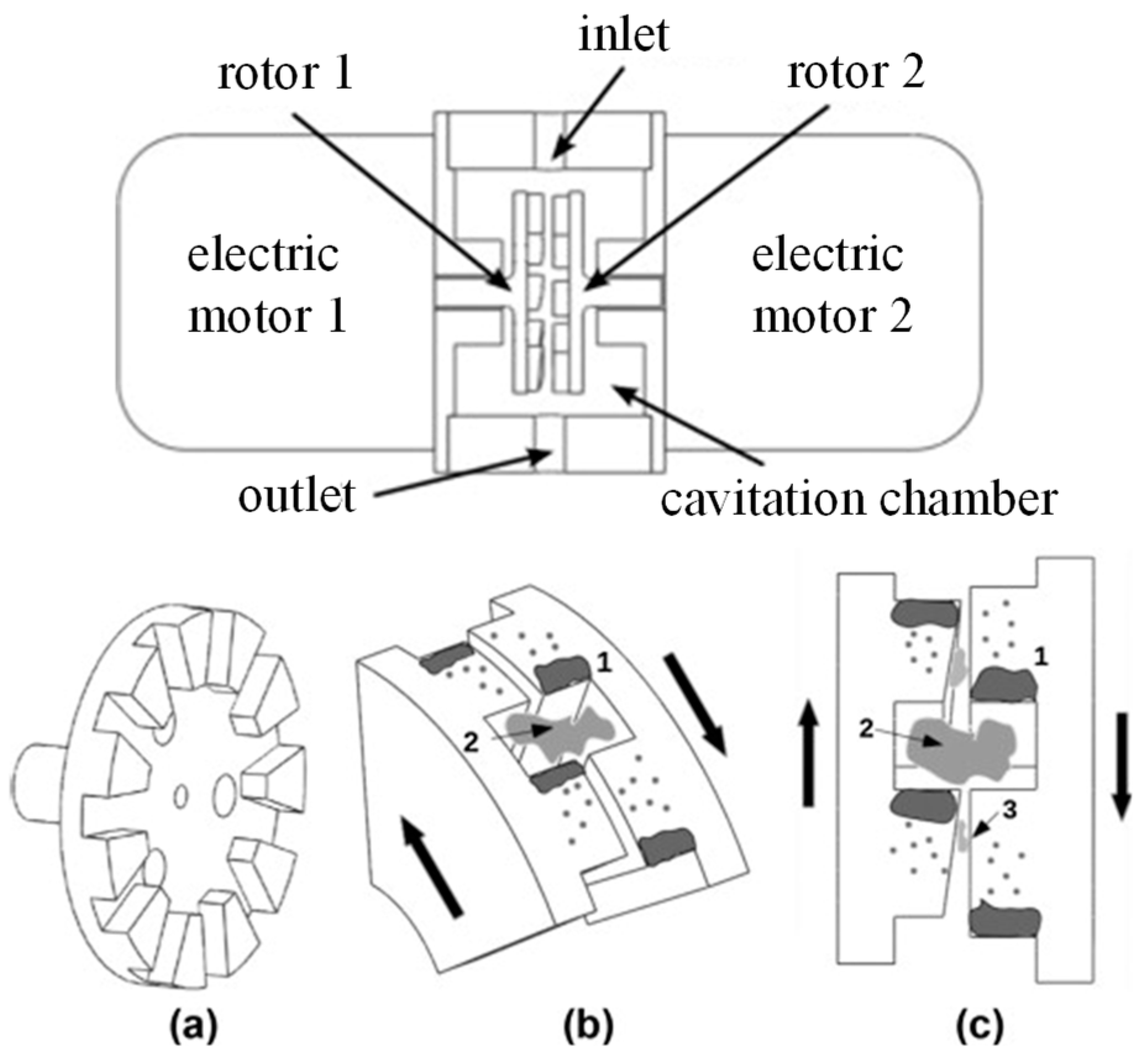
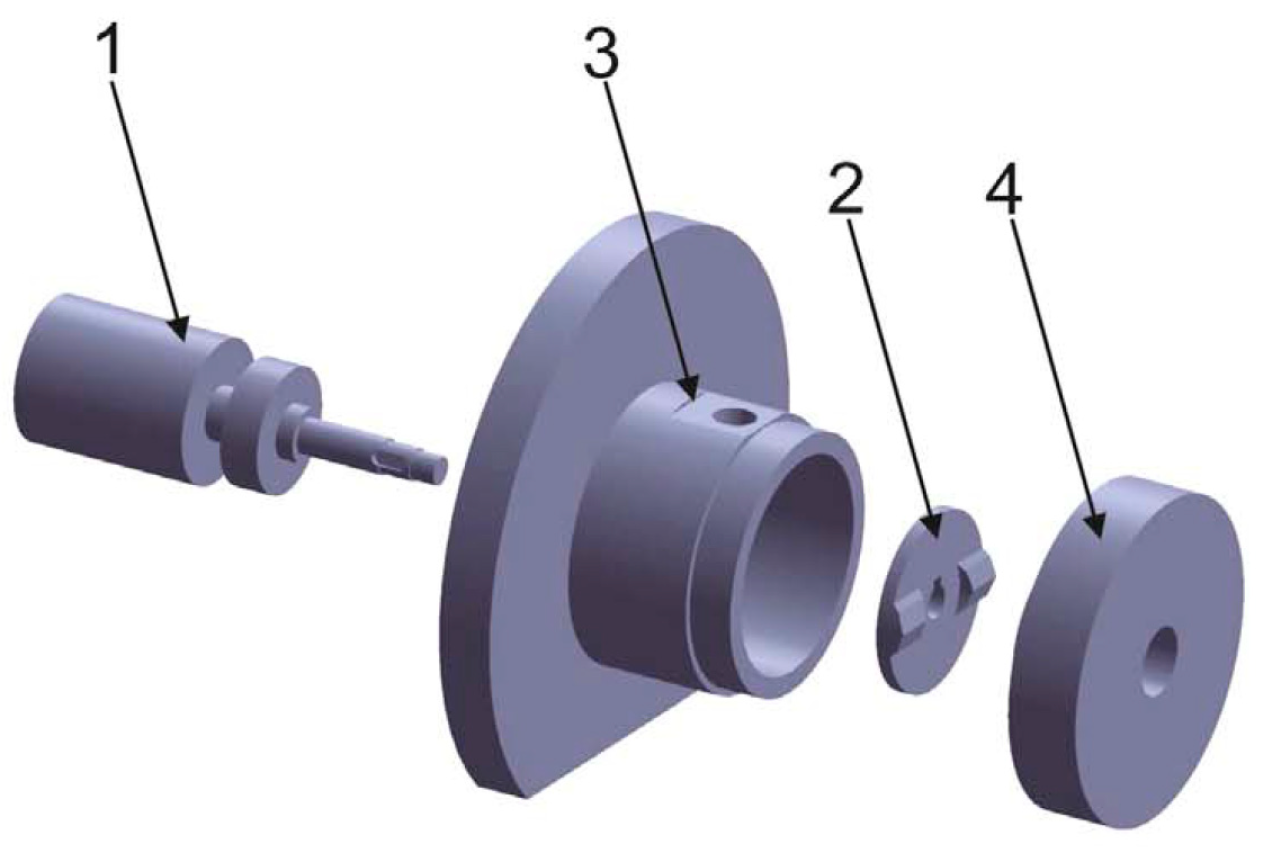
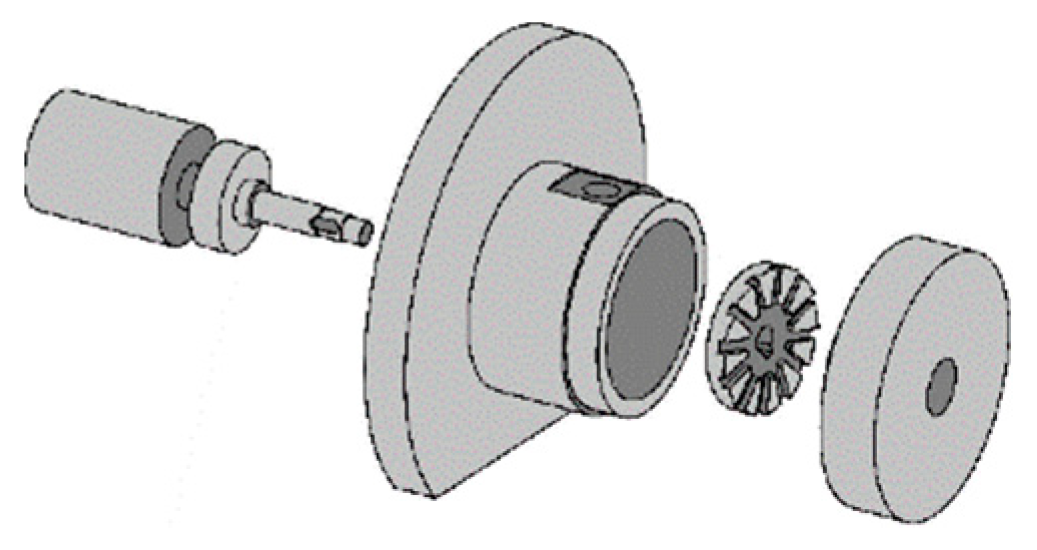

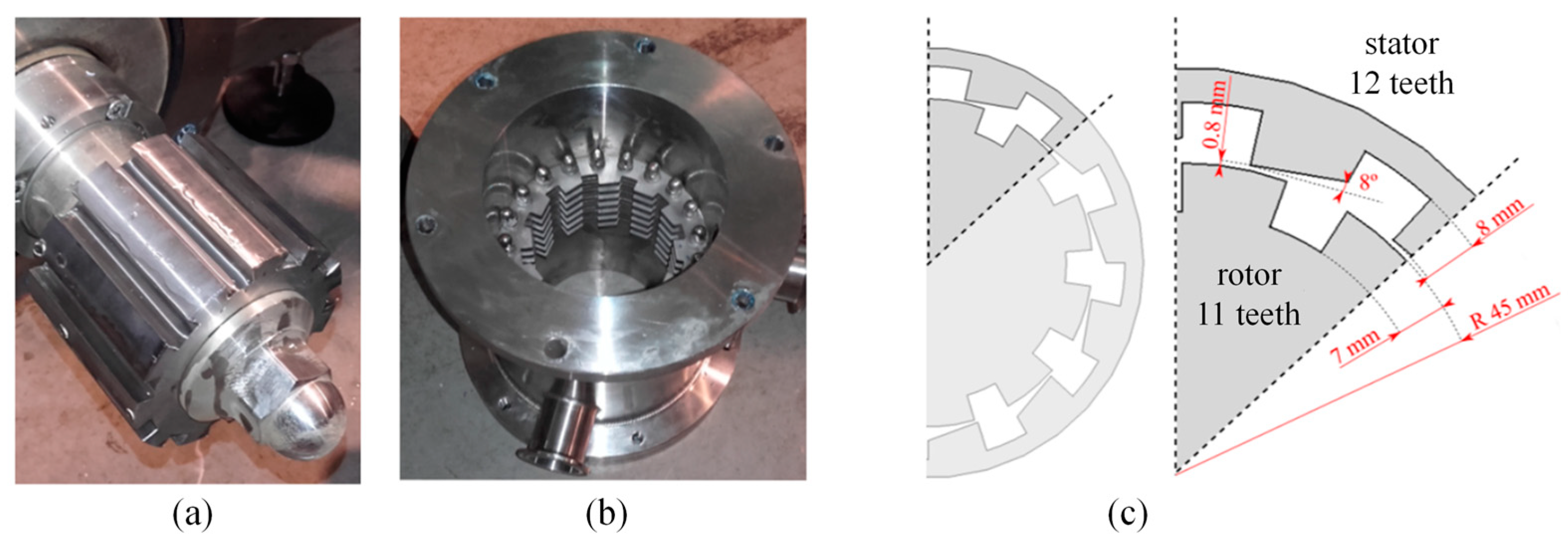
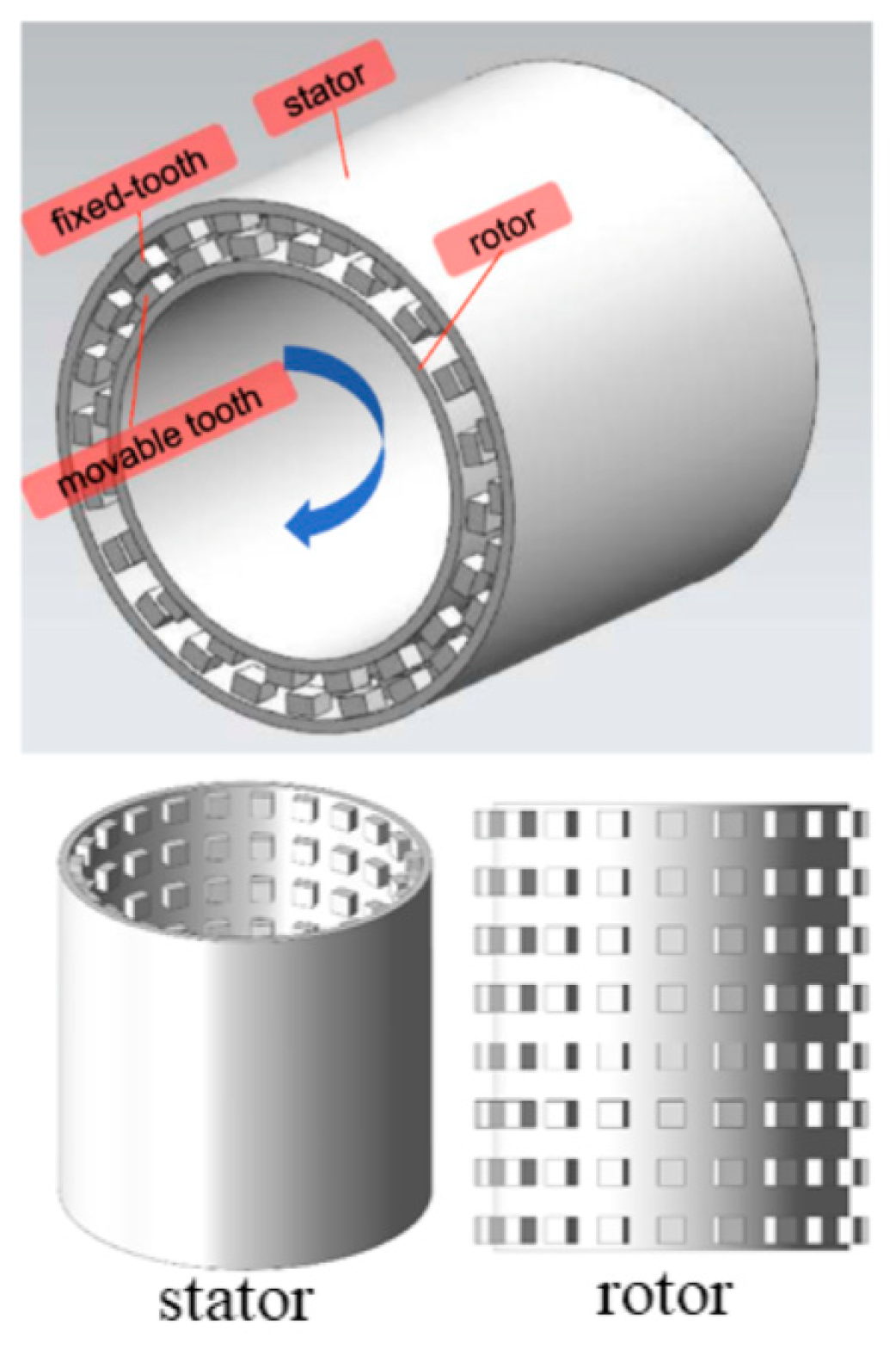


| Number on Figure 4 | Explanation |
|---|---|
| (1) | maximum bubble size is reached |
| (2) | upper boundary collapses faster due to the vicinity of rigid surface |
| (3) | microjet formation and occurrence of water hammer pressure |
| (4) | deformation of the surface |
| (5) | flow moves radially outwards |
| (6) | secondary evaporation/splashing [63] |
| (7) | formation of micro bubbles, spherical collapse, and generation of shockwaves |
| Device Type | Sample Treated | Sample Parameters | Process Parameters | Achieved Effect | Process Efficiency | Reference |
|---|---|---|---|---|---|---|
| indentation type RGHC | wastewater from wood finishing industry | pH = 6.18 COD0 = 38000 mg/L V = 4 L | Np = 195 t = 20 min Q = 39 L/min T = 20–25 °C | CR = 56% at 2200 RPM | 4.6 mg COD/kJ * | Badve et al. (2013) [80] |
| CR = 89% at 2200 RPM and 5 g/L of H2O2 | 8.4 mg COD/kJ ** | |||||
| SD RGHC | WAS from WWTP | TS > 10 g/L sCOD0 = 46 mg/L sKN0 = 6.3 mg/L (Soluble Kjeldahl Nitrogen) V = 196 L | Np = 20 t = 55 min Q = 71 L/min | DD = 57% 12.7% biogas enhancement sCODcav = 602 mg/L sKNcav = 71 mg/L | 75 kJ/g sCOD | Petkovšek et al. (2015) [38] |
| SD RGHC | Secondary Pulp and Paper Mill Sludge | V = 500 L sCOD0 = 509 mg/L Nt = 8.1 mg/L Pt = 0.6 mg/L | t = 30 min | CR = 46% sCODcav = 1023 mg/L Nt;cav = 43 mg/L Pt;cav = 2.9 mg/L | 0.758 kg/€ | Sežun et al. (2019) [121] |
| sCODcav = 2895 mg/L Nt;cav = 128.1 mg/L with NaOH addition (pH 10) | 1.835 kg/€ | |||||
| SD RGHC | Wastewater influent sample | pH = 7.8 pH = 7.9 V = 800 L | Np = 30 t = 90 min Q = 4.4 L | CR = 20% at 2290 RPM CR = 13% at 2700 RPM | N/A | Kovačič et al. (2020) [110] |
| ARHCR | Secondary sewage sludge | pH = 6.5 COD0 = 4480 mg/L sCOD0 = 34 mg/L VSS = 2120 mg/L TS = 3726.5 mg/L | CR = 33% sCODcav = 633 mg/L VSS = 540 mg/L 92.7% average particle size reduction | SR = 42.3% | Kim et al. 2019 [68] | |
| ARHCR | sewage sludge | COD0 = 2350 mg/L sCOD0 = 93 mg/L particle size 10–1000 μm | pinlet = 0.2 bar Q = 6.3 L/min | sCODcav = 588 mg/L 94.7% average particle size decrease Particle size with temperature control in the 10–100 μm range Particle size without temperature control in the 1–10 μm range | N/A | Kim et al. (2020) [116] |
| Multiple SD RGHC | WAS or WAS mixed with pig slurry | pH = 7.3 ± 0.1 TS = 7200 mg/L COD0 = 4505 ± 1744 mg/L sCOD0 = 76 ± 35 mg/L V = 40 L | 5600 RPM Np = 22 t = 30 min P = 5730 W | DD = 26% | 271 kJ/g sCOD | Vilarriogh et al. (2020) [41] |
| pH = 7.2 ± 0.3 TS = 70,000 mg/L COD0 = 4505 ± 1744 mg/L sCOD0 = 6320 ± 1950 mg/L V = 200 L | t = 240 min P = 6930 W | DD = 17.4% | 16 kJ/g sCOD | |||
| PD RGHC | wastewater influent sample | pH = 7.6 COD0 = 1432 mg/L T0 = 16 °C V = 200 L | 5600 RPM Np = 15 t = 5.88 min | CR = 28% COD removal = 813 g COD/h | 8.25 kWh/kg COD 3.28 kWh/m3 | Gostiša et al. (2021) [79] |
| pH = 8.1 COD0 = 1432 mg/L T0 = 16 °C V = 200 L | t = 6.49 min | CR = 31% COD removal = 815 g COD/h | 8.22 kWh/kg COD 3.62 kWh/m3 | |||
| PD RGHC | wastewater influent sample | pH = 8.2 COD0 = 648 mg/L | Np = 60 2700 RPM t = 116 min P = 5.6 kW Q = 6.9 L/min | CR = 18% 92.8 g COD reduced; 48 g COD/h | 116.7 kWh/kg COD | Gostiša et al. (2021) [94] |
| pH = 7.3 COD0 = 635 mg/L | Np = 30 2700 RPM t = 47 min P = 6.7 kW Q = 8.6 L/min | CR = 21% 7.6 g COD reduced; 138.8 g COD/h | 48.3 kWh/kg COD | |||
| pH = 7.3 COD0 = 635 mg/L | Np = 60 2700 RPM t = 93 min P = 6.7 kW Q = 8.6 L/min | CR = 27% 13.7 g COD reduced; 88.2 g COD/h | 76 kWh/kg COD | |||
| PD RGHC | WAS | pH = 6.9 EC = 1121 µs/cm Salinity = 0.36 ppm DO = 0.39 mg/L TS = 16.7 ± 0.6 mg/L VS = 12.4 ± 0.5 mg/L COD0 = 16.7 ± 0.9 mg/L sCOD0 = 207 ± 14 mg/L sTOC0 = 292.5 ± 34.6 mg/L sTN0 = 146.5 ± 2.1 mg/L TP0 = 536.5 ± 4.9 mg/L sTP0 = 65.5 ± 3.5 mg/L | 2700 RPM Δp = 102 kPa p0 = 22 kPa Q = 8.0 L/s P = 6.3 kW Np = 60 V = 320 L | CR = 5% DD = 3.3 ± 0.4% sCODcav = 530 ± 1 mg/L sTOC = 345 ± 11.3 mg/L Increase in DOM relevant values Increase in fluorescence Decrease of total metal concentration | SE = 1.41·103 ± 0.16·103 kJ/kgTS SESS = 73 ± 2 kJ/g sCOD | Kolb-Repinc et al. (2022) [72] |
| 3000 RPM Δp = 99 kPa p0 = 26 kPa Q = 8.7 L/s P = 6.5 kW Np = 60 V = 320 L | CR = 4% DD = 6.0 ± 0.6% sCODcav = 459 ± 57 mg/L sTOCcav = 331.5 ± 7.8 mg/L Increase in DOM relevant values Increase in fluorescence Decrease of total metal concentration | SE = 1.34·103 ± 0.1·103 kJ/kgTS SESS = 89 ± 4 kJ/g sCOD |
Disclaimer/Publisher’s Note: The statements, opinions and data contained in all publications are solely those of the individual author(s) and contributor(s) and not of MDPI and/or the editor(s). MDPI and/or the editor(s) disclaim responsibility for any injury to people or property resulting from any ideas, methods, instructions or products referred to in the content. |
© 2023 by the authors. Licensee MDPI, Basel, Switzerland. This article is an open access article distributed under the terms and conditions of the Creative Commons Attribution (CC BY) license (https://creativecommons.org/licenses/by/4.0/).
Share and Cite
Blagojevič, M.; Rak, G.; Bizjan, B.; Kolbl Repinc, S. A Review on Rotary Generators of Hydrodynamic Cavitation for Wastewater Treatment and Enhancement of Anaerobic Digestion Process. Processes 2023, 11, 514. https://doi.org/10.3390/pr11020514
Blagojevič M, Rak G, Bizjan B, Kolbl Repinc S. A Review on Rotary Generators of Hydrodynamic Cavitation for Wastewater Treatment and Enhancement of Anaerobic Digestion Process. Processes. 2023; 11(2):514. https://doi.org/10.3390/pr11020514
Chicago/Turabian StyleBlagojevič, Marko, Gašper Rak, Benjamin Bizjan, and Sabina Kolbl Repinc. 2023. "A Review on Rotary Generators of Hydrodynamic Cavitation for Wastewater Treatment and Enhancement of Anaerobic Digestion Process" Processes 11, no. 2: 514. https://doi.org/10.3390/pr11020514






